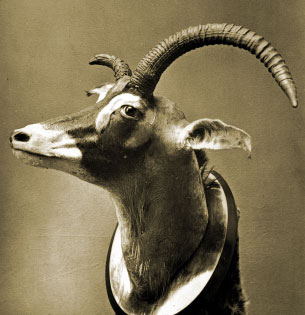Taxidermy before the Victorian and Edwardian eras was a rather crude affair, mostly used by hunters, explorers, and scientists to preserve specimens for lack of a better method. It was only during the beginning of the 20th century that taxidermy really evolved into the art form seen today.
Prior to the 20th century, most “taxidermists” would really have been upholsterers, who treated the tanned animal hide like a chair cushion. After it had been tanned at a tannery, the hide would be sewn up and stuffed with what was available, usually cotton, rags, sawdust, or similar materials. Unfortunately, this produced some very saggy, shapeless, terrible-looking end products, and the practice gave taxidermy a rather bad reputation. What was even worse, however, was that items like glass eyes or artificial noses were not yet in use. Since these body parts couldn’t be treated by tanning the same way leather could, they were often left as-is, which meant that they would decay over time. So, in addition to not creating lifelike mounts of hunters’ kills or biological specimens, this mode of taxidermy failed at adequately preserving the pieces it made.

During the early 20th century, the practice of “stuffing” animals began to fall by the wayside in favor of mounting them over more anatomically-correct wooden models. The skins would generally still have to be filled out with some form of stuffing, however, unlike the boneless things of the 18th and 19th century, Victorian taxidermy specimens more closely resembled their living counterparts. As big game hunting came into fashion, wealthy sportsmen (like then-President Theodore Roosevelt) began to commission taxidermists to make hunting trophies for them. Unlike the lifelike poses most specimens are placed into today, the fashion for Victorian taxidermy was to place creatures in particularly savage, snarling postures that emphasized the bravery of the hunter who’d taken them down. These were generally used as décor pieces in sitting rooms or libraries in Victorian homes. Fortunately, since glass eyes and other artificial soft tissue parts were in use by then, the display continuing to decay was not an issue.
Some taxidermists, however, were less interested in creating a realistic look than in using specimens (usually small ones, like rabbits or squirrels) to set up little tableaux. Walter Potter is perhaps the most famous example of this art form, as he created several famous dioramas of rabbits at school, guinea pigs playing in an orchestra, and kittens having tea. Most of his work didn’t simply involve mounted animals, either- almost all of them had extremely detailed, suitably miniaturized props and costumes, as well.
Though Victorian taxidermy was still a ways off from resembling the highly realistic specimens modern taxidermy produces, it was during this time that it really began to develop into a sophisticated skill. While previous specimens were only good for preserving unusual animals or kills out of necessity, the 20th century took taxidermy into being a sought-after decorative art form.
